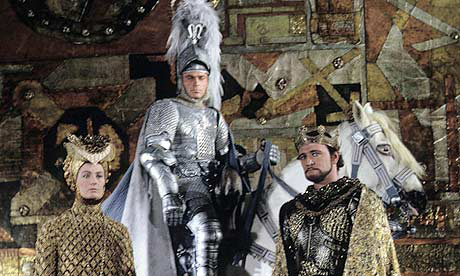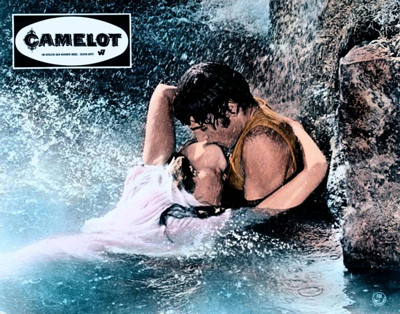
 |
|
|
|
The critics weren't kind to Warners' Fall 1967 offering Camelot. The adaption of the much-celebrated 1960 Lerner / Loewe Broadway successhad entered the mythology of the 1960s when it was claimed as a metaphor for the new Presidential Administration. The Democratic White House was Camelot, JFK King Arthur and his bride Jackie the lustrous Guenevere. The segment of the country that considered JFK a knight in shining armor, tended to think in those terms. Camelot is the story of a noble Utopia that might have been, had the Round Table Arthur's dreams not been smashed. The tragic finish came true three years later, and the Camelot - Kennedy association stuck for good. 
Told in a long flashback, Camelot finds young King Arthur (Richard Harris) worried about his marriage and wishing for an escape back to his childhood, when the sorcerer Merlyn (Laurence Naismith) had amazed him with the wonders of nature. The equally idealistic Guenevere (Vanessa Redgrave) finds Arthur fascinating, especially his progressive ideas for the realm. But after they marry, she becomes infatuated with the French knight Sir Lancelot (Franco Nero), an undefeated champion and a man of impeccably pure ideals. Taking offense at Lancelot's boastful nature, she sends her best knights to defeat him at the jousts. Not long afterward, they become lovers. As in the Garden of Eden, guilt and shame make the adulterers miserable. King Arthur tries to deny the relationship until the pretender to the throne Mordred (David Hemmings) forces the issue, and the royal infidelity comes out in the open. The law states that Guenevere has committed treason, and must die at the stake. Lacking a solution that will leave his kingdom and his marriage intact, Arthur is wracked by indecision. Jack Warner snapped up the screen rights for the play in the same way he had My Fair Lady and later would 1776. The stage star of both Lady and Camelot, Julie Andrews, would see other actresses taking her place in the big screen adaptations. She got payback of sorts when her double whammy of Mary Poppins and The Sound of Music won unanimous praise. The feature film of Camelot was not quite as lucky, even though it did reasonably well as a reserved seat Road Show attraction before going wide in general release (cut by almost half an hour). The critics gave it grief for not improving on the play, and denigrated Richard Harris' mannered acting as well as his deep blue eye shadow makeup (which indeed seems ridiculous in some shots). Bosley Crowther seemingly didn't have a clue when he called Harris' performance "campy". 1 Italian actor Franco Nero took a general drubbing as a pretty boy incapable of holding a thought, let alone a performance. 
Most of the critical praise was reserved for Vanessa Redgrave, who indeed looks luminous in a natural hairstyle and gives the impression of wearing no makeup at all. Certainly the most expressive of the three actors, Ms. Redgrave carries the emotional weight of the picture and is the center of the attention at almost all times. She's the only movie star I know who has managed to look sexy with tears running down her face and fluid streaming from her nose. Redgrave might remember the movie fondly, as she and Franco Nero become lovers on the set, a relationship that has lasted almost 50 years. The saddest part of Camelot is that some of it looks downright cheap. The castle and most of the English exteriors bake under the harsh, "surf's up" sunlight of Southern California; this is the driest Camelot in film history. The movie is stingy with extras and 'scope', with the big wedding scene showing Arthur and Guenevere walking to the altar through a room empty save for hundreds of candles. Finally, for much of the picture director Joshua Logan seems to be simply phoning in his contribution. He pays attention to his close-ups, and a couple of the musical numbers have some pre- MTV flow to them ("If Ever I Would Leave You", especially) but most scenes are thrown together haphazardly. The stylized studio sets for the forest (both icy and green) are no more interesting than those seen on the average TV variety special of the day. Arthur walks among the fallen trees at one point, past various 'forest friend' animals that are all too clearly tethered in place in tree stumps, etc.. The legendary Round Table receives so little attention that its first interesting angle is when it's being broken under the hooves of a knight's horse. When Lancelot races to rescue Guenevere, his mounted entourage barely trots into the castle grounds. The camera angles are wholly indifferent. It's as if the knight were delivering the morning paper. That's enough with the negative waves, as there are things in Camelot to savor beyond the above-mentioned Vanessa Redgrave. The music is still attractive, although some of the songs were always too cute; the lyrics of "What Do the Simple Folk Do?" and "Then You Can Take Me To the Fair" seem too much like parody, spoofery. Although not backed up by the film's visuals, "Follow Me" has always been a favorite, as the aspect of Arthur's childlike faith in goodness is one of the film's strong points. "Guinevere" stirs up the emotions for the threatened stake-burning more than anything in the picture, especially with Richard Harris moping and whining with his indecisive Hamlet schtick instead of doing something. Oddly enough, the scene that comes together for Harris is the wraparound, when he's preparing for a losing battle with Mordred and wondering where all his dreams went. Harris is lyrical in his wistfulness, the light on the castle in the background (is this a real location?) is perfect, and our feelings soar when Arthur is reenergized by the enthusiasm of the young boy, Tom. After all of the film's "Camelot is melting in the dark" histrionics, the finale is inspiring. 
Savant (that's me) lived about eighty miles from Los Angeles in his High School years so trips here were usually school related. I came once at age 11 for How the West Was Won and not again until my Freshman year, to see Camelot at the Cinerama Dome. So I'll personally always remember the film as having no flaws whatsoever, and being incredibly romantic and sexy -- Redgrave looked so ... intent when she sneaks into Lancelot's bedchamber. I think I kissed my new girlfriend for the first time on that trip too, and imagined myself quite a ladies' man. Ask somebody what movies really made an impact on their memories, and chances are it will be something they saw when they were first dating. Warner Home Video's Blu-ray of Camelot presents the show in its best light. The visually successful scenes really pop, and the uncompressed audio sells the music better than ever before. The original DVD from 1998 played several reels of the film out of sync, a problem that is completely fixed here. I'm going to have to keep that older copy, however -- the new Blu-ray uses the same chapter stops but gives no description anywhere of their contents. I like to dip back into older musical purchases, and will have to refer to the old disc if I want to locate my favorite songs. A second disc is a CD with a music sampler containing several songs from the soundtrack. The fancy insert booklet is in full color, which betrays the almost monochrome design of some scenes. The disc's copywriters had difficulty finding interesting things to say about the movie -- it isn't exactly productive to write too much about the history of the play. We are told that JFK loved the play, but not that its star was Julie Andrews. The souvenir booklet resorts to padding its pages with empty content, such as a list of "The Memorable Tunes of Camelot". I flipped through the attractive book, but saw no listing for the un-memorable ones.
On a scale of Excellent, Good, Fair, and Poor,
Camelot Blu-ray rates:
Footnotes:
1. One critic started an urban myth (?) with the news that a close-up of Richard Harris supposedly showed a visible Band-Aid. (Nobody every complains about vaccination scars). Like the wristwatches in Spartacus, an actual goof has never been pointed out to these eyes.
Reviews on the Savant main site have additional credits information and are often updated and annotated with reader input and graphics. Also, don't forget the 2011 Savant Wish List. T'was Ever Thus.
Review Staff | About DVD Talk | Newsletter Subscribe | Join DVD Talk Forum |
| ||||||||||||||||||